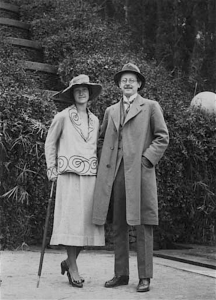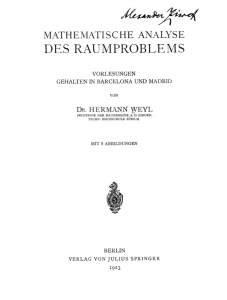In mid-January 1922, Hermann Weyl arrived in Malaga for a long stay in our country. The initiative had come from Esteban Terradas, an active Catalan scientist-engineer, who invited him to give a course of eight lectures in Barcelona as part of the Cursos Monogràfics d’Alts Estudis i d’Intercanvi organised by the Pedagogical Council of Catalonia. (Hadamard had already come in the same context, and Einstein would arrive the following year.) The Barcelona lessons took place in the first half of March, and in the second half the Weyls went to Madrid to repeat them; there he spoke in French, in the capital in Spanish, a language which, according to Terradas, “with all fluency and finesse you have taken the trouble to learn”. They had plenty of time to stroll around the country beforehand, and it seems they were particularly interested in getting to know the Andalusian area. The picture shows them visiting the Alhambra.

Weyl arrived in Spain in the company of his wife, the philosopher Helene, and together they were able to indulge their high-bourgeoisie cultural tastes, visiting Seville, Cordoba, Granada, etc. Helene Weyl is the author of Andalusische Reiseblätter (Andalusian Travelogues, 1923) and of a small work on archaeological remains from the Caliphate period in Cordoba. The Weyls were delighted with her visit to the Peninsula, and Mrs. Weyl had the opportunity to meet Ortega y Gasset in Madrid, who made a great impact on her; thus the translation of Ortega’s works into German was set in motion, and this put him on the European map, so to speak. She was to be the translator, among many other works, of The Revolt of the Masses, a book which, incidentally, was written with the German Weimar Republic in mind. Mrs Weyl and Ortega were very close, and their correspondence is published in Spanish (the relationship became very strained around 1939 because of political disagreements: she was a Jewish exile, he saw the Francoist rebels in a favourable light).
A written version of Weyl’s lectures, translated into German, was published in 1923 under the title Mathematische Analyse des Raumproblems (Mathematical Analysis of the Space Problem; Springer, 1923); there were plans for a publication in Catalan but, unfortunately, they did not come to fruition.

Weyl conceived his lectures in Spain as a complement to the ideas contained in his famous book Raum, Zeit, Materie (Space, Time, Matter, 5th edn, 1923), which contained his contribution to the theory of General Relativity. The book dealt with the “space problem” from the point of view of group theory, in a modernised version of the so-called Helmholtz-Lie problem. This problem calls for characterising the groups of transformations of constant curvature spaces (Euclidean, hyperbolic and elliptic) within the general framework of groups of transformations, as a result of the requirement of free mobility of rigid bodies (or its purely mathematical translation). But Weyl’s treatment of the question in Raum, Zeit, Materie was brief, and in the lessons we are discussing he focused on the question from a purely geometrical point of view.
 His intention was to justify the more general features of the Riemannian metric of space, as a result of very general considerations on infinitesimal displacements; and this led him to the first gauge theories. The reason was that the condition of free mobility of rigid figures was meaningless in the context of General Relativity, and could only hold at the infinitesimal or local level. Weyl therefore set about generalising Riemannian differential geometry to achieve a “purely infinitesimal” gauge geometry (on this subject, see various articles by Erhard Scholz).
His intention was to justify the more general features of the Riemannian metric of space, as a result of very general considerations on infinitesimal displacements; and this led him to the first gauge theories. The reason was that the condition of free mobility of rigid figures was meaningless in the context of General Relativity, and could only hold at the infinitesimal or local level. Weyl therefore set about generalising Riemannian differential geometry to achieve a “purely infinitesimal” gauge geometry (on this subject, see various articles by Erhard Scholz).
As a Jesuit journal of the time put it, “the object of the lecturer was to present the most modern theories on the philosophical and physical problem of space. From Euclidean geometry, through Lobatchewski [sic], Riemann, Helmholtz, Lie, Minkowski, Levi-Civita and Einstein, to the lecturer’s own latest conception, everything was carefully reviewed. The lecturer distinguished the role played in each theory by the notion of the straight line (trajectory of a free point, both in space and in the Minkowski Universe) and the null element (trajectory of light). With them, the various axiomatics are established; what happens is that as the problem becomes more complicated, the a priori and a posteriori elements of any given metric become more evident. That of the lecturer, dazzlingly exposed in the last two lectures, is outlined in the fourth edition of his book Raum, Zeit, Materie, already translated into French…; but its global synthesis is not yet a year old, and in these lectures, which we hope will soon see the public light, it has been exposed for the first time in Spanish” (Ibérica, vol. XVII, no. 430, p. 340-341).
Springer’s book is dedicated to Esteban Terradas, as a sign of friendship and admiration for his technical and scientific efforts in Catalonia. In a romantic and high-flown tone, Weyl says: “Never before and nowhere else have I found, as there, in such a harmonious union, good will – even enthusiastic –, a clear vision of what is necessary and what is feasible, and serious energy for work”. At the end of the foreword he thanks those who invited him to Barcelona and Madrid for the extraordinarily friendly reception in their country, and expresses the wish that the exchange of thoughts and cultural goods between “the German spirit” (sic) and Spain, “whose activity has awakened anew in all scientific fields and the arts”, will become “ever more fruitful”.
(More details on the lectures, especially in Barcelona, can be found in a work by A. Roca Rossell, ‘Hermann Weyl entre nosaltres. El curs de 1922 i algunes de les seves repercussions’).

Leave a Reply